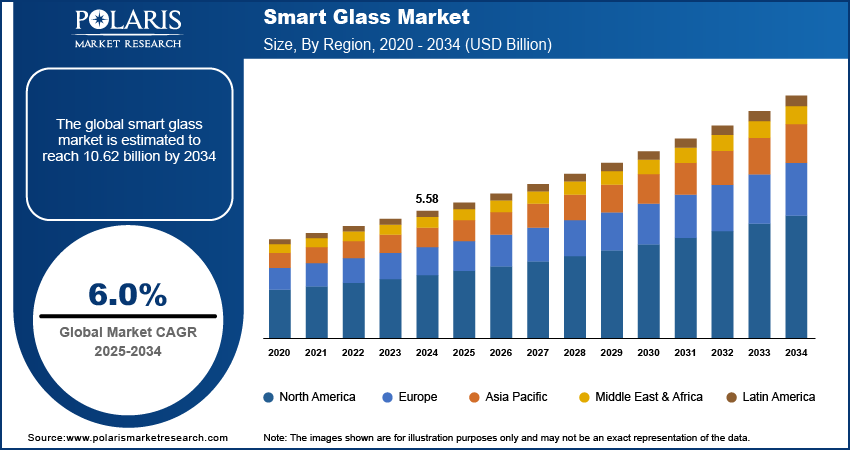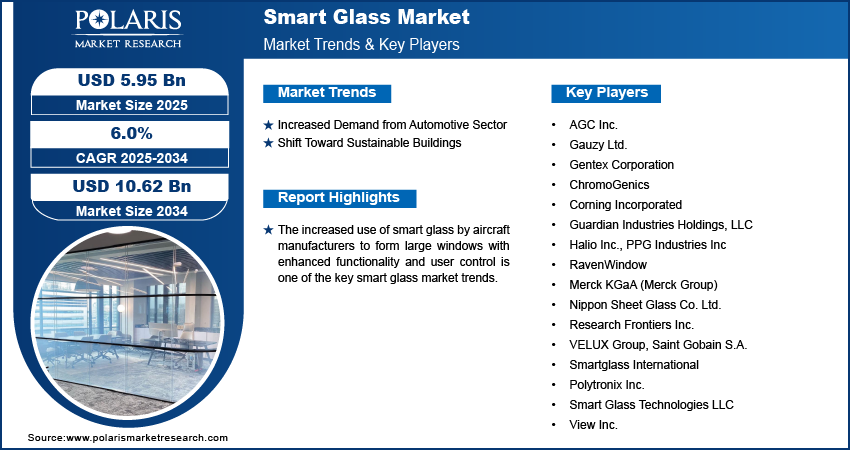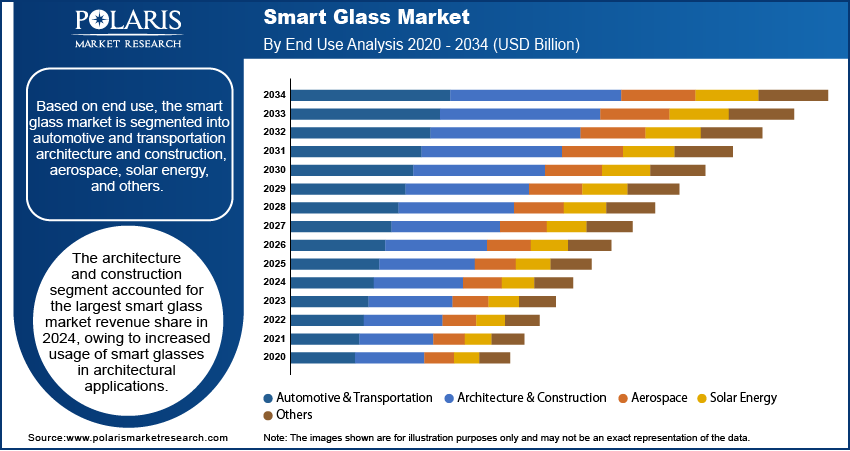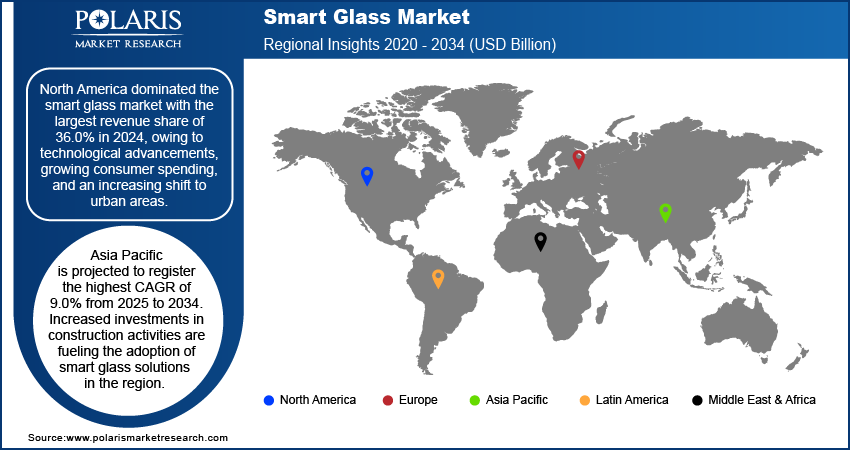
Smart Glass Market Size, Share, Trends, Industry Analysis Report
: By Technology (Photochromic, Liquid Crystal, Suspended Particle Display, Electrochromic, Thermochromic, and Others), End Use, and Region (North America, Europe, Asia Pacific, Latin America, and Middle East & Africa) – Market Forecast, 2025–2034
- Published Date:Feb-2025
- Pages: 114
- Format: PDF
- Report ID: PM1400
- Base Year: 2024
- Historical Data: 2020-2023
Smart Glass Market Overview
The global smart glass market size was valued at USD 5.58 billion in 2024. The market is projected to grow from USD 5.95 billion in 2025 to USD 10.62 billion by 2034. It is projected to exhibit a CAGR of 6.0% from 2025 to 2034.
Smart glass, or switchable glass, is a type of intelligent glass that can change its optical properties in response to electrical or thermal signals. The glass offers control of light entering a space, along with improved privacy. The optical properties of the glass can be switched through light sensors, switches, movement sensors, or universal remote control. Smart glass finds applications in hospitality interiors, healthcare facilities, marine and aviation applications, government and military sectors, and educational institutes.

To Understand More About this Research: Request a Free Sample Report
Rising industrialization, growing urbanization, and increasing demand from the automotive sector are among the primary factors driving the smart glass market growth. Rising applications in sunroofs, increasing demand for passenger vehicles, and growing modernization of automobiles further accelerate the adoption of smart glass.
The increased use of smart glass, especially SDP glass, by aircraft manufacturers to form large windows with enhanced functionality and user control is one of the major smart glass market trends. The higher potential of minimalist architecture provides a unique opportunity for functional improvement in the smart glass market.
Smart Glass Market Dynamics
Increased Demand from Automotive Sector
The integration of smart glass in automobiles offers several benefits, including glare control, decreased noise, and UV stabilizer and protection. Also, smart glass reduces the heat entering the vehicle, which can reduce fuel consumption needed by the automotive HVAC system and increase vehicle efficiency. The modernization of vehicles to improve vehicle performance and efficiency, along with the implementation of stringent vehicular regulations, is also driving the demand for smart glass in the automotive industry. The growing demand for smart glasses from the automotive sector is fueling the smart glass market expansion.
Shift Toward Sustainable Buildings
The growing shift toward sustainable buildings is attributed to the greater need for energy savings, stringent carbon goals, and increasing aging of existing buildings. The integration of smart glass in buildings enables light control and heat management and provides enhanced privacy. It also allows for the entry of natural ambient lightning in open floor plans and can provide superior air quality and flexible use of space. Further, smart glass can be easily controlled through smartphones and is often integrated with automation systems for the execution of smart or connected buildings. Therefore, the growing shift toward sustainable buildings is another factor driving the smart glass market development.

Smart Glass Market Segment Insights
Smart Glass Market Outlook – Based on Technology
The smart glass market, based on technology, is segmented into photochromic, liquid crystal, suspended particle display, electrochromic, thermochromic, and others. The suspended particle display segment is anticipated to register the highest CAGR of 9.5% from 2025 to 2034. The suspended particle display has nano-scale particles suspended in a liquid and offers little light transmittance to provide privacy. It uses electricity through a control panel to line up particles and become transparent. Rapid technological advancements in the construction industry, increasing penetration of passenger vehicles, and modernization of automobiles are factors fueling the suspended particle display segment growth.
Smart Glass Market Assessment – Based on End Use
The smart glass market, based on end use, is segmented into automotive and transportation, architecture and construction, aerospace, solar energy, and others. The architecture and construction segment accounted for the largest smart glass market revenue share in 2024. Smart glass can be used in walls, doors, windows, elevators, and skylights in architectural applications. The glare reduction feature of smart glass reduces unwanted glare from sunlight and creates optimal lighting levels inside the building structure. Also, it finds applications in regulating the temperature in structures. Further, the ability of smart glass to self-clean offers an enhanced user experience at minimal maintenance costs.

Smart Glass Market Regional Analysis
The report offers smart glass market insights into North America, Europe, Asia Pacific, Latin America, and the Middle East & Africa. North America dominated the market with the largest revenue share of 36.0% in 2024. Technological advancements, growing consumer spending, increasing shift to urban areas, and the presence of international players are the key factors driving the market growth in North America. The introduction of stringent regulations regarding energy savings, rising automotive penetration, and increasing construction and development activities boost regional market growth.
Asia Pacific is anticipated to register the highest CAGR of 9.0% from 2025 to 2034. Increased investments in construction activities fuel the adoption of smart glass solutions in Asia Pacific. In addition, the presence of a strong real estate sector drives the regional demand for smart glass. The growing shift toward sustainable buildings is anticipated to offer significant growth opportunities for the smart glass market in the region during the forecast period.

Smart Glass Market – Key Players and Competitive Insights
The smart glass market is characterized by fragmentation. It has the presence of several small and medium-sized companies. The leading market players are making significant investments in R&D to extend their product lines. Also, they are undertaking several strategic initiatives such as mergers and acquisitions, and partnerships to expand their global reach. To expand and survive in a more competitive environment, the smart glass market players must offer cost-effective items.
In recent years, the market for smart glass has witnessed several technological and innovation breakthroughs, with key players seeking to provide advanced solutions that help meet sustainability goals. The smart glass market report offers a market assessment of all the leading market players, including AGC Inc.; Gauzy Ltd.; Gentex Corporation; ChromoGenics; Corning Incorporated; Guardian Industries Holdings, LLC; Halio Inc.; PPG Industries Inc; RavenWindow; Merck KGaA (Merck Group); Nippon Sheet Glass Co. Ltd.; Research Frontiers Inc.; VELUX Group; Saint Gobain S.A.; Smartglass International; Polytronix Inc.; Smart Glass Technologies LLC; and View Inc.
List Key Companies in Smart Glass Market
- AGC Inc.
- Gauzy Ltd.
- Gentex Corporation
- ChromoGenics
- Corning Incorporated
- Guardian Industries Holdings, LLC
- Halio Inc.
- PPG Industries Inc
- Merck KGaA (Merck Group)
- Nippon Sheet Glass Co. Ltd.
- Research Frontiers Inc.
- VELUX Group
- Saint Gobain S.A.
- Smartglass International
- Polytronix Inc.
- Smart Glass Technologies LLC
- RavenWindow
- View Inc.
Smart Glass Industry Developments
October 2023: Guardian Industries Holdings, LLC introduced the SunGaurd SNX 70+ coated glass. The company stated that the new glass comes with a visible light transmission of 68%. Also, it has a solar heat gain coefficient of 0.28 when applied to Guardian UltraClear low-iron glass.
October 2023: Saint Gobain announced an investment of USD 400 million across various businesses, including solar glass, adhesives, ceramics, mortars, and float glass. According to the company, the investments are part of its expansion phase in Tamil Nadu, India.
Smart Glass Market Segmentation
By Technology Outlook
- Photochromic
- Liquid Crystal
- Suspended Particle Display
- Electrochromic
- Thermochromic
- Others
By End Use Outlook
- Automotive & Transportation
- Architecture & Construction
- Aerospace
- Solar Energy
- Others
By Regional Outlook
- North America
- US
- Canada
- Europe
- Germany
- France
- UK
- Italy
- Spain
- Netherlands
- Russia
- Rest of Europe
- Asia Pacific
- China
- Japan
- India
- Malaysia
- South Korea
- Indonesia
- Australia
- Rest of Asia Pacific
- Middle East & Africa
- Saudi Arabia
- UAE
- Israel
- South Africa
- Rest of the Middle East & Africa
- Latin America
- Mexico
- Brazil
- Argentina
- Rest of Latin America
Smart Glass Market Report Scope
|
Report Attributes |
Details |
|
Market Size Value in 2024 |
USD 5.58 billion |
|
Market Size Value in 2025 |
USD 5.95 billion |
|
Revenue Forecast by 2034 |
USD 10.62 billion |
|
CAGR |
6.0% from 2025 to 2034 |
|
Base Year |
2024 |
|
Historical Data |
2020–2023 |
|
Forecast Period |
2025–2034 |
|
Quantitative Units |
Revenue in USD billion and CAGR from 2025 to 2034 |
|
Report Coverage |
Revenue Forecast, Market Competitive Landscape, Growth Factors, and Trends |
|
Segments Covered |
|
|
Regional Scope |
|
|
Competitive Landscape |
|
|
Report Format |
|
|
Customization |
Report customization as per your requirements with respect to countries, regions, and segmentation. |
FAQ's
The market size was valued at USD 5.58 billion in 2024 and is projected to grow to USD 10.62 billion by 2034.
The market is projected to register a CAGR of 6.0% from 2025 to 2034.
North America accounted for the largest region-wise market size in 2024.
A few key players in the market are AGC Inc.; Gauzy Ltd.; Gentex Corporation; ChromoGenics; Corning Incorporated; Guardian Industries Holdings, LLC; Halio Inc.; PPG Industries Inc; RavenWindow; Merck KGaA (Merck Group); Nippon Sheet Glass Co. Ltd.; Research Frontiers Inc.; VELUX Group; Saint Goblin S.A.; Smartglass International; Polytronix Inc.; Smart Glass Technologies LLC; and View Inc.
The architecture and construction segment accounted for the largest smart glass market revenue share in 2024.
The suspended particle display segment is anticipated to register the highest CAGR during 2025–2034.
